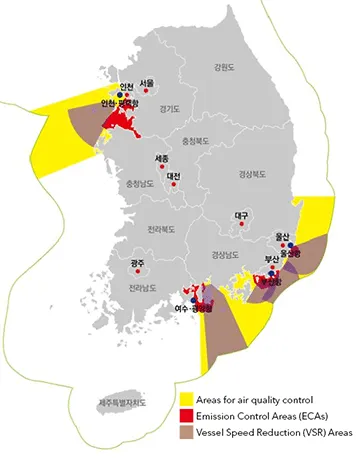To reduce particulate emissions from ocean going ships in its ports, South Korea has released a “special act on improvement of air quality in port areas”. Find out more about the Korean ECA and its Vessel Speed Reduction (VSR) programme in this statutory news.
Relevant for ship owners and managers sailing vessels to South Korean ports.
The South Korean Ministry of Maritime Affairs and Fisheries (“MOF”) has announced an air quality control programme that defines selected South Korean ports and areas as Emission Control Areas (ECA). A programme with maximum sulphur limits (0.1%) and speed limits will support the effectiveness of the programme. The following ports/areas are covered by the air quality control programme:
- Incheon, Pyeongtaek, Dangjin Area
- Yeosu, Gwangyang area
- Busan
- Busan(west) area
- Ulsan area
The air quality control initiatives in South Korea consist of two parts:
- Sulphur restriction
- From 1 September 2020 it is mandatory to use fuel with max. 0.1% sulphur content while berthing. Vessels will be required to use max 0.1% sulphur fuel when berthing/anchoring for the times set out below:
- Berthing: 1 hour after completion of berthing until 1 hour before de-berthing.
- Anchoring: 1 hour after completion of anchoring until 1 hour before leaving anchor.
- From 1 January 2022: It will be mandatory to use fuel with max. 0.1% sulphur content while navigating ECAs.
- From 1 September 2020 it is mandatory to use fuel with max. 0.1% sulphur content while berthing. Vessels will be required to use max 0.1% sulphur fuel when berthing/anchoring for the times set out below:
- Speed reductions
The port areas selected will be designated as “VSR programme Sea Areas”. Each Sea Area will span 20 nautical miles in radius, measured from a specific lighthouse in each port. Ships should navigate no faster than a maximum speed of 12 knots for container ships and car-carriers, 10 knots for other ship types, when moving from starting point to an end point within a Sea Area, see table:- Ships included in the programme:
Ships covered under for the VSR programme differ at each port, but must be over 3,000GT and among the top 3 “fine-dustemitting” ship-types (see chart above). - Lower speed pays off:
Under the VSR programme, ships will have their port facilities fees lowered when they enter defined port areas at speed levels as defined above. For affected ships, port entry/leave fee (current 111 KRW per ton), will be discounted. The discount ceiling will differ between the ports. Container ships, for example, which traditionally enters port at relatively high speeds, will enjoy up to a 30% discount, while other ships will be granted a 15% discount.
- Ships included in the programme:
Recommendations
Shipowners and operators should be aware of the following regulations:
South Korean ECA - From 1 September 2020, ships berthing or anchoring at certain Korean ports (South Korean ECA), must use max. 0.1% sulphur content fuel (or reduce emissions below this target). From 1 January 2022 this limit also applies when navigating the ECA area.
Vessel Speed Reduction (VSR) Programme
Port fees will be reduced for ships which lower their speeds to set targets defined in the VSR programme Sea Areas.
References
- Ministry of Oceans and Fisheries article (KOR)
- Ministry of Oceans and Fisheries news on “Vessel speed reduction(VSR) programme to start december this year” (ENG)
Contact
- For customer: DATE – Direct Access to Technical Experts via My Services on Veracity
- Otherwise: Use our office locator to find the nearest DNV GL office.
